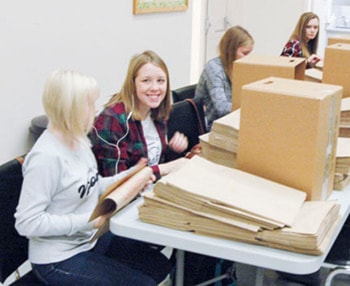According to a recent provincial report, one out of every five children in the province live in poverty.
“Between the Vital Signs report in 2013 and the Youth Esteem strategy report in late fall 2013 and 2014, it is shocking,” said Aaron McRann, executive director or the Community Foundation of the South Okanagan-Similkmeen. “It is very clear that one of the key issues in our community is the difficulty in making it work and actually making a go of it. That is paying rent, access to decent food and enough money left over. Most of us, the other 80 per cent, don’t have any concept how difficult that is.”
The 2014 B.C. Child Poverty Report Card released by First Call: B.C. Child and Youth Advocacy Coalition shows little progress has been made to reduce child and family poverty in the province. McRann said there is a tendency for people to think it is as simple as going out getting a job.
“Seldom is it that easy. Most people living with major challenges most of us can’t comprehend,” said McRann. “Penticton ranks as one of the bottom 10 in this province in child poverty.” The situation here is even more dire than the province as a whole.”
Reasons behind it include seasonal work and the costs of housing. It is such an issue that 44 per cent of the CFSO granting goes towards children and youth organizations. McRann said that is significant when there is seven other categories they have when considering where to put money.
According to the report, in March just over 97,000 people in B.C. were helped by food banks, 31 per cent of those were children. At the Penticton Salvation Army Food Bank, Joey Cyr, Community ministry supervisor, said they see steady numbers of people using their services.
“I would say our numbers are pretty much on par with that report in terms of statistics. It doesn’t come as a surprise those numbers,” he said. “Fundraisers like 10,000 Tonight and our kettles are all things that we do at this time of the year that see us through the whole year.”
Penticton high school students will be knocking on doors on Dec. 3 to collect non-perishable food items from 5 to 8 p.m. for the 10,000 Tonight food drive. Bags are being inserted into the Penticton Western News Nov. 28 issue and residents can leave it on their doorstep for easy pickup.
While the goal is to reach 10,000 items, the need for more is there. Last month the Penticton food bank gave away 351 hampers and Cyr said out of that 236 children were fed. They also had 4,700 lobby visitors who also received hampers or food that the Salvation Army has available to hand out daily.
Cheryl Mixon, chairperson of the First Call Coalition said a comprehensive poverty reduction plan from the government of the province is long overdue.
The report card has 19 recommendations that they believe will reduce the child poverty rate to seven per cent or less by 2020. These include adopting the $10 a day child care plan, increasing welfare rates and federal child tax benefits, paying living wages and increasing affordable housing options for families among others.
“Consistently high child poverty rates should worry us all,” said Scott Graham, Associate Executive Director of SPARC BC. “The social and economic costs that result from poor nutrition, limited opportunity, and chronic family stress are huge. Failing to invest now to decrease the negative effects poverty has on child development for such a large percentage of our child population is a false economy. BC is not a poor province and we can afford to take better care of each other.”
One of those recommendations is increasing and indexing the minimum wage. First Call has calculated for a two-parent, two-child family with both parents working full time the living wage in the Central Okanagan in 2013 would need to be $18.01. That is just to meet their basic needs.
McRann said it is not all gloomy news. There are things being done to combat the problem in the South Okanagan-Similkameen, but he added it is not going to erase itself without the help of government.
“I’m confident looking forward with this new city council’s direction. I think they have some positive energy not only to improving the economy but the social network in our community which is great news,” said McRann. “The rest of us need to continue to do our part and follow our hearts and contribute to things that we think are important.”
